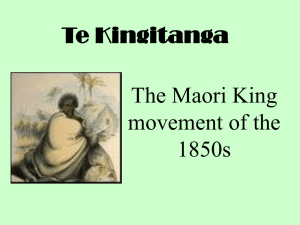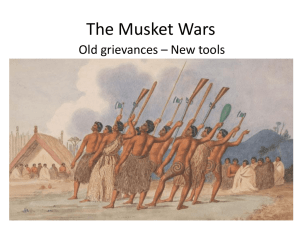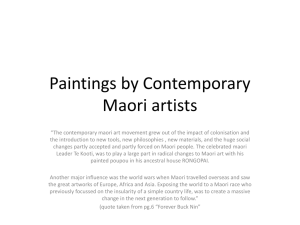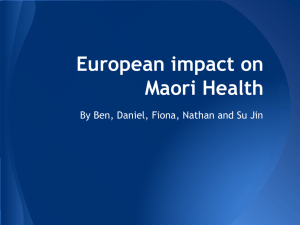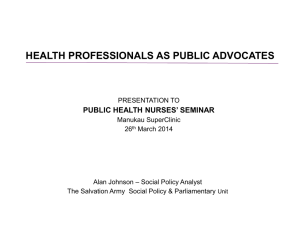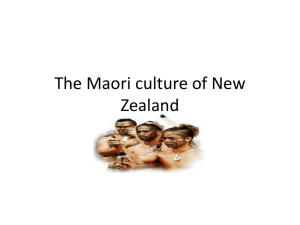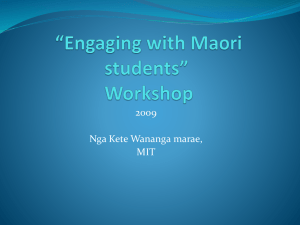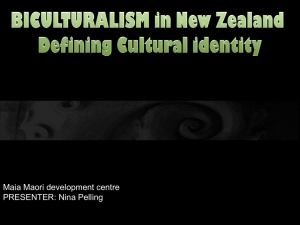multiculturalism and art education
advertisement
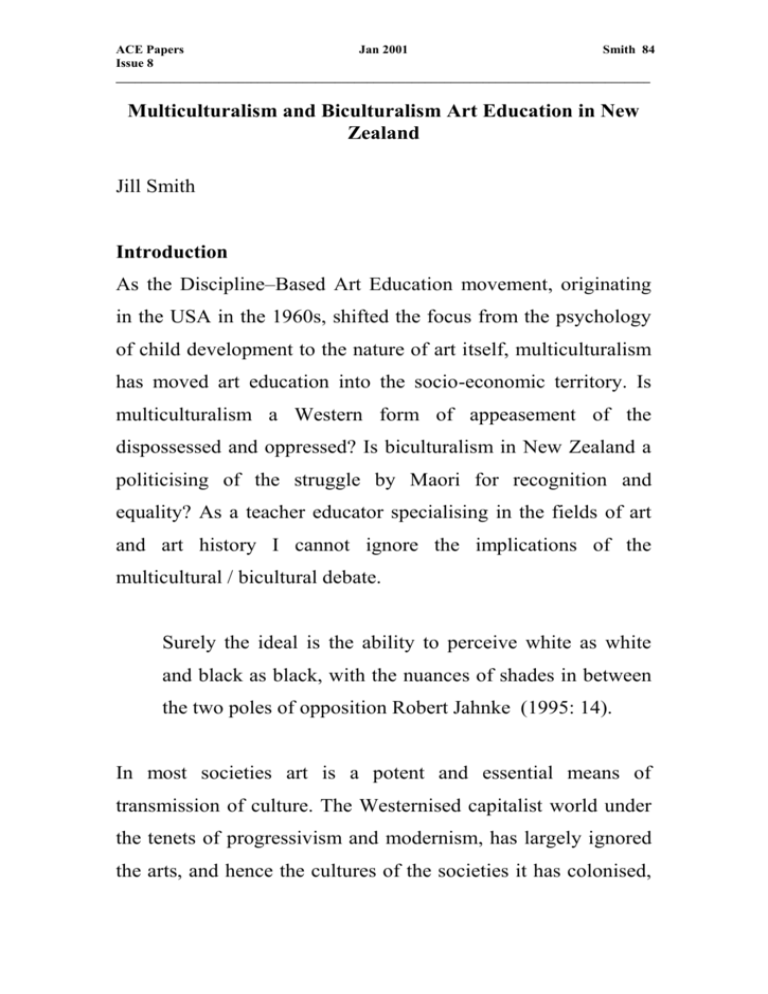
ACE Papers Jan 2001 Smith 84 Issue 8 ___________________________________________________________________________________ Multiculturalism and Biculturalism Art Education in New Zealand Jill Smith Introduction As the Discipline–Based Art Education movement, originating in the USA in the 1960s, shifted the focus from the psychology of child development to the nature of art itself, multiculturalism has moved art education into the socio-economic territory. Is multiculturalism a Western form of appeasement of the dispossessed and oppressed? Is biculturalism in New Zealand a politicising of the struggle by Maori for recognition and equality? As a teacher educator specialising in the fields of art and art history I cannot ignore the implications of the multicultural / bicultural debate. Surely the ideal is the ability to perceive white as white and black as black, with the nuances of shades in between the two poles of opposition Robert Jahnke (1995: 14). In most societies art is a potent and essential means of transmission of culture. The Westernised capitalist world under the tenets of progressivism and modernism, has largely ignored the arts, and hence the cultures of the societies it has colonised, 85 Smith Jan 2001 ACE Papers Issue 8 ___________________________________________________________________________________ and imposed its own monocultural educational programmes. The dominant groups exponentially tried to assimilate minority groups into the mainstream in order to deal with the disaffection, distrust and unrest that colonisation or subjugation has promoted,. While cloaked in benevolence, these programmes of assimilation infer that minorities should have the advantage of participation in the major culture. Grant & Sleeter (1989) see assimilation as only one dimension of multiculturalism. They define multiculturalism as a highly complex, evolving and frequently contradictory field. They list five categories of multiculturalism spanning from conservative assimilation to radical self-determination. These categories are worth elaborating, as most have been evident in New Zealand educational policies, and in the field of secondary education have impacted upon art and art history curricula. 1. Multiculturalism as the conservative reaction to minority unrest The Western world’s earliest reaction to the unrest of minorities was to include them in the establishment’s education system. This is a sometimes grudging recognition that they had some right of access to schooling. As free education is extended to all citizens it is then for individuals to take best advantage of the opportunities offered. If individuals fail to do so, no blame could ACE Papers Jan 2001 Smith 86 Issue 8 ___________________________________________________________________________________ be attached to the education systems. There was no necessity to recognise the art and culture of the minorities, and in New Zealand, for example, there was active disapproval of inclusion of Maori language and art in school programmes. 2. Multiculturalism as the rejection of assimilation Assimilist education, as provided by the dominant groups, did inform the socially and politically disadvantaged of their situation and helped increase their determination to achieve equally. Exercise of political power was seen as essential, not to survive and live with oppression, but to overthrow it. While African Americans generated the civil rights movement, there was a quick international response, supported by indigenous peoples in colonised countries, immigrants co-opted as a cheap labour force, ethnic minorities trapped within the new boundaries established after the two major world wars, and by sectors of gender and class. Conservative educational response to the militancy of the oppressed was what Sleeter (1996) calls ‘benign pluralism’. Teachers were encouraged to be sensitive to minority differences, including such things as ethnic crafts, music, dance and ceremony in the school programme. Such action was often only a superficial interpretation of cultural behaviour and belief and an appeasement of conscience of those in power. In New 87 Smith Jan 2001 ACE Papers Issue 8 ___________________________________________________________________________________ Zealand, Maori words were put to English hymn tunes and Maori mythology translated into romantic fairy stories to be illustrated. Educators have also provided programmes to enable culturally different students to fit into classrooms and society. Resources supplement the standard curriculum and time is provided to help students ‘catch up’. Such approaches are still essentially assimilist. The problem is with the student, not the school. 3. Multiculturalism as pluralism in the curriculum An assimilation rationale holds that ‘other’ groups need, both for their own advantage and for the benefit of the nation, to learn and accept the majority cultural mode. However, rejection of assimilation by the disadvantaged and oppressed has been marked. Educators, recognising the failure of assimilationist policies, started to teach about the motivations common to all societies, whilst recognising different modes of expression. In New Zealand this was evident in the 1992 J1-F7 Art Education Syllabus, and an approach which persists in the Arts in the New Zealand Curriculum published in September, 2000. This ‘human relations’ approach may educate students of the majority sector to be more understanding of the beliefs, values and practices of other groups and reduce prejudice towards them. It may also raise the self-esteem and sense of self-worth of ACE Papers Jan 2001 Smith 88 Issue 8 ___________________________________________________________________________________ the people and the communities of minority groups. Chalmers states: Cultural pluralism is a reality and reluctant, grudging, or tacit recognition by one culture of an-other must be replaced by genuine appreciation and proactive corrective action; ... no racial, cultural, or national group is inherently superior to another; … no one group’s art is basically superior to another’s; … equality of opportunity, in our classrooms and elsewhere, is a right that must be enjoyed by every student regardless of ethnic, cultural, or other differences (Chalmers, 1996: 2). 4. Multiculturalism as self-determination To take steps to ameliorate oppression is a daunting prospect for the majority sector for it threatens the existing power structure. Recognition of oppression tends to force acknowledgement of responsibility for past wrongdoings. Even when enslavement, taking of land by force, or imposition of a religion which conflicted with traditional beliefs might be admitted, the majority powers argue that such wrongs cannot fairly be placed upon today’s inheritors, nor are there logical means of righting them. Grant & Sleeter (1989) argue against this, in favour of a ‘single studies’ approach which aims to establish social equity and to revive what is important in a culture, so that it can stand 89 Smith Jan 2001 ACE Papers Issue 8 ___________________________________________________________________________________ in its own right with other cultures. It equates with Freire’s ‘critical consciousness’ – an awareness of the otherness of others. For the art educator, the single studies approach requires not only positive, non-discriminatory action by the art teacher, but a much more substantial revision of curricula and resources than is implied in assimilationist and human relations programmes. The Kohanga Reo and Kaupapa Maori initiatives are tangible steps taken by Maori towards self determination. In New Zealand, concepts such as restoration, revitalisation and maintenance of ‘traditional’ indigenous art, are often seen by the mainstream as impractical and irrelevant. Tradition is seen as the past, ignoring that all cultures are in constant evolution. What an ethnic group defines as its culture is its culture, as postmodernists might claim that what is art is what an institution calls art. 5. Multiculturalism as social reform Those who argue for radical social reform seek equitable distribution of power within the education structure, a reduction in discrimination and prejudice, and social justice and equal opportunity. Such reformists would require that all schools follow such policies and practices, whatever the make-up of ACE Papers Jan 2001 Smith 90 Issue 8 ___________________________________________________________________________________ their populations. The reformist approach is more radical than others discussed above, in so far as it requires an overhaul of the schooling system and a revision of the established Western values systems. Grant & Sleeter maintain that education towards a reconstructed society enables students to become analytical and critical thinkers capable of examining their life circumstances and the social stratifications that keep them and their group from fully enjoying the social and financial rewards of this country Grant & Sleeter (1989: 54) . The reform of society to ensure individual and collective freedoms and equality of opportunity is not a new aim. If there is a shift, it is to focus upon reform of Western society itself, in its relationships to those races, nations, and groups which have been seen to be subservient to it. Major reform is unlikely to be resolved by educational theory or by schooling as it presently exists. Although most New Zealand teachers consider themselves to be benevolent social reformers, they are naive if they do not recognise that they work within a system designed and managed by a dominant power structure. However, as is evident in all parts of the world, the rapidly growing recognition by subservient sectors of their condition and of the causes of it, aided by both education and by electronic 91 Smith Jan 2001 ACE Papers Issue 8 ___________________________________________________________________________________ communication, is accompanied by knowledge of the weapons of change and reform. Those who hold power and are cognisant of this, may be persuaded in their own interest to institute and support reform towards equity and equality. Cultural policy in New Zealand art education There is no single or simple definition of multiculturalism, internationally or in New Zealand. The situation in New Zealand is further complicated by the existence of bicultural policy. The Treaty of Waitangi has meant that in New Zealand the emphasis has been upon two cultures, that of Maori and the predominantly British society. The small Chinese and Yugoslav/Dalmatian communities, many of whom had been in New Zealand for up to 100 years, have received no attention. With increasing immigration by Pacific Islanders, Asians and Europeans, New Zealand has in the past forty years developed a more polyglot population. Until very recently there have been few moves of any significance towards multicultural art education. There is some friction between those who favour bicultural action aimed at improving the circumstances of the Maori, and the claims which, the now more ethnically diverse society, makes for multicultural policies. ACE Papers Jan 2001 Smith 92 Issue 8 ___________________________________________________________________________________ In respect of Maori, New Zealand provided state-funded schooling in Native Schools established in 1914 to assimilate Maori into the mainstream. Jones et al (1990: 123-156) relay how the earliest ‘mission’ schools taught their curriculum in Te Reo but later, that in order to get state subsidies, changed to instruction in English. Their view of the Native Schools Act (1867) is that state schooling from that time onwards has been marked by significant social and cultural effects. Education in things Maori was not seen as a responsibility of the Pakeha schooling system. Indeed it is doubtful whether the government of the day approved any form of it (Jones et al 1990). There were some moves to restore and sustain Maori culture. In 1926, for example, Sir Apirana Ngata initiated the Maori Arts and Crafts Act and established a national school of carving at Rotorua. One of its first graduates, Pine Taiapa advocated in the 1930s that Maori and Pakeha attend school together and learn among other things, Maori arts and crafts as it affects their after-school days in a better understanding of each others’ shortcomings, associations and mainly citizenship’ (Taiapa 1972: 36). His willingness to co-operate with and to release Maori knowledge to Pakeha was to be significant for the development of bicultural art education in New Zealand from the 1950s. 93 Smith Jan 2001 ACE Papers Issue 8 ___________________________________________________________________________________ Under a Labour Government, Beeby, Director General of Education, established in 1945 an Arts and Crafts Department and appointed Gordon Tovey as its first superintendent. Tovey, much influenced by the new-wave education of the liberal/progressivist regime, believed that a ‘creative’ blending of Maori and Pakeha art could result in an interweaving of spiritual and aesthetic purpose which he believed had been lost by Western society. Tovey recruited a group of 13 young Maori art advisers, most of whom had had predominantly Pakeha educations (Smith, 1996b). He gained Taiapa’s support in providing training for these advisers at a time when traditional knowledge of custom, language and art was in danger of being totally lost. Most of these advisers (among them Ralph Hotere, Cliff Whiting and Paratene Matchitt) have become respected New Zealand artists, some working in traditional idioms, and others moving largely into Western styles but with a powerful assertion of Maori ideology (Smith, 1996b). Tovey sought a cross-cultural blending of creative energy, using dance, music, rhythm and visual arts as the medium of expression. In today’s terms, Tovey appears paternalistic. He appeared to see Maori as a pure and simple people untainted by Western materialism. Art education could integrate Maori and Pakeha within a unified culture which respected its dual origins. Although he obviously respected Maori art, his interest was not ACE Papers Jan 2001 Smith 94 Issue 8 ___________________________________________________________________________________ in maintaining it but using it to ‘reform’ art in schools. Paradoxically, his vigorous promotion of the tenets of creativity and individuality, and the expression of the free spirit are at odds with the Maori emphasis on respect for established precedent, and obedient apprenticeship (Neich, 1996). The first formal move to recognise the art of cultures other than Maori and European is recent, beginning with the J1 – F7 Art Education Syllabus in 1992, and further emphasised in The Arts in the New Zealand Curriculum of 2000. While the curriculum makes provision for cultural diversity, it will become clearer in the future whether multicultural approaches become accepted practice. The Bicultural Imperative The New Zealand situation is unique. Because of the existence of a Treaty now given force under the Waitangi Tribunal, biculturalism is politically motivated. Thus it must be distinguished from sociological imperatives towards multiculturalism. The establishment of the tribunal owes much to the growth of radicalism among young, militant Maori, who do not have the patience of an older generation who expected Pakeha to treat them well. Politicised through educations obtained in Pakeha institutions, they have moved from expectation to demand. 95 Smith Jan 2001 ACE Papers Issue 8 ___________________________________________________________________________________ Under the Treaty of Waitangi of 1840, which sustains the rights and property of Maori in equal terms with other subjects under the Crown of Great Britain, Maori culture and language are required dimensions of school curricula, and must be recognised in the charters of tertiary institutions. As a tertiary art educator, I have a legal obligation (Ministry of Education Curriculum Statements) to prepare all student teachers in respect of the teaching of Maori art. As a scholar of Maori art, I have strong convictions regarding these responsibilities. I am, nonetheless, Pakeha and as such the question of my right to comment on things Maori is a problematical one. Jahnke suggests: Anyone can speak about a culture without an awareness of that culture. In order to speak for Maori one must earn the right. The right is not self-imposed, but is decreed through genealogy, through acknowledgement or through deed. Even Pakeha may earn the right to speak for Maori but it is a right conferred by Maori not by Pakeha (Jahnke, 1995: 11). My acceptance as one of the first Pakeha woman to study Maori Art in the Masters programme at Auckland University, while in Western terms, my consequent research gives me authority to comment on my field. I am more conscious of, and follow, Jahnke’s view. I am given the right by Maori to speak in some places and at certain times. However, as a Pakeha educator, ACE Papers Jan 2001 Smith 96 Issue 8 ___________________________________________________________________________________ required to fulfil legal Treaty obligations, I am aware of the consequences of the small number of Maori holding the (Western) qualifications requisite to employment in tertiary institutions and a similarly small number of Maori students enrolled in tertiary art programmes. Maori teachers are rare. Maori art teachers even more rare. Between 1980 and 1996 only 14 Maori graduates from tertiary art institutions trained in the secondary teacher education art course at the Auckland College of Education. Of these, most are now working at tertiary level in Maori studies or visual arts departments, or as independent artists. Only a few continue teaching in secondary schools (Smith, 1996a). Pakeha teachers who face the dilemma of being required to teach ‘Maori Art’ are aware that in most instances if they do not teach it no one will. Some of them teach it with integrity, as best they can from the basis of such knowledge as they possess. Some, by doing so, have met with Maori disapproval. On the other hand approval may be gained when the individual teacher can demonstrate not only an adequate knowledge of Maori art but of the protocols under which it exists. The conflict of Western progressivist doctrines of ‘child art’ with the long established patterns of traditional Maori art education is a further issue in art education today. New Zealand’s art curricula still emphasise Western interpretations of 97 Smith Jan 2001 ACE Papers Issue 8 ___________________________________________________________________________________ art education as being the ‘right’ way. Disparagement of reproduction by students of existing art forms and training in techniques, such as was required by Maori, persists. Such discrimination in pedagogy has to be seen as a refusal by the Pakeha dominated education system to acknowledge the effectiveness of an alternative model of art education which produces work of extraordinary vitality and quality. The conflict remains unresolved. Recently, younger Maori artists and educators have become strong politicising advocates. A new and more radical group are intolerant of assimilationist practices. Jahnke states: For biculturalism to be more than a pathetic fallacy requires empathetic negotiation across the boundaries of cultural reality. To presuppose a priority of vision defined solely by Western perception merely perpetuates the cultural capital of the elite as the sole criterion of cultural legitimacy….After a hundred and fifty years we are finally renegotiating that (Waitangi) treaty but the mere factor that re-negotiation is necessary at all speaks volumes about the assumptions made in the name of superior civilisations and the primacy of one (only) ‘mother tongue’ (Jahnke, 1995: 10). ACE Papers Jan 2001 Smith 98 Issue 8 ___________________________________________________________________________________ The work of contemporary Maori artists is reaching a New Zealand and international audience, and there is little doubt about the power of its messages. However, while New Zealand art curricula may specify some study of the ‘significance and forms of Maori art’, there remains a bulimic preoccupation with Western art. The issue is not only about inclusion of ‘Maori art’ in the curriculum, but who will teach it, and under what terms. That issue is further complicated by the controversy over appropriation and Maori protests over ‘cultural stripping’. Whether this be the incorporation of Maori motifs in works by artists supportive of and sympathetic to the Maori situation, by commercial insignia and promotional material that re-works Maori motifs to suit Pakeha ends, or by such blatant if not derisive ‘send-ups’ of the tiki, as in Dick Frizzell’s work. (Tiki, an exhibition at Gow-Langsford Gallery 1992). Pakeha critics and commentators, applying a Western aesthetic, react with accusations that Maori contemporary artists constantly use Western images and technology - a confusion of purpose with methodology. The Western artist who borrows the forms or spirit of a dominated culture still remains in a position of dominance, but the third-world (i.e. indigenous/tribal) artist who also incorporates materials and motifs from the developed 99 Smith Jan 2001 ACE Papers Issue 8 ___________________________________________________________________________________ world remains an outsider (Whitecliffe, 1999: 217 citing Martin). Although the Treaty of Waitangi provides a political interpretation of bicultural responsibility, legislation will not in itself prevent borrowings and interactions, whether seen as appropriation or not. What the Pakeha art educator must recognise is that he or she who borrows or appropriates is aware of the consequences of such actions, not under the heading of artistic licence, but in the arena of cultural power and sensitivity. The legislated requirement in the Ministry of Education curriculum documents to include Maori studies in the curriculum does not ensure that the educational rationale is well argued. New Zealand is becoming a multicultural society and it is imperative that art education recognises and actions the issues and conflicts raised by politically-motivated biculturalism and socially and ethically motivated multiculturalism. A way ahead? To achieve equity in art education in a multicultural society dominant powers must have the will to surrender assumptions of the singularity and superiority of the arts of their culture, and recognise not only the possibility but also the advantage of co- ACE Papers Jan 2001 Smith 100 Issue 8 ___________________________________________________________________________________ existence and of multiple structures. While such concepts can be advanced in theoretical terms, action requires partnerships in policy making and implementation. The minority or disadvantaged sector must have a voice in definition and formulation of art education strategy and curriculum. In their ‘Position Statements’ for teaching art in the multicultural classroom Wasson et. al. quote curriculum theorist Apple: It is therefore important to challenge the assumptions of the dominant ideology by asking the following questions: ‘Whose knowledge is it? Who selected it? Why is it organised and taught in this way? To this particular group? (Apple cited in Wasson et al 1990:236). They add to Apple’s questions another one, ‘For what reason(s)?’ In other words, who is empowered and who is disempowered in the educational process? Multiculturalism then is concerned with issues of Western supremacy in Westernised and colonised nations, and with the policies and strategies which might redress inequity. Without doubt, the struggle for equity is real and unresolved, and will 101 Smith ACE Papers Issue 8 ___________________________________________________________________________________ continue. Jan 2001 However, I advance the view that in postmodern terms, multiculturalism might be better defined, not so much as an issue of conflict, but as one of recognition of the existence of multiple cultural manifestations that deserve proper attention. The role of art is often more significant in the maintenance of the cultural fabric of many societies than is the role of ‘fine arts’ in Western society. The arguments for effective art education in such societies have as much, if not more, credence than the arguments advanced by Western art educators. We face a world in which it is by no means inconceivable that the Western powers may no longer be dominant. It is useful, if perhaps frightening, for the descendants of British settlers in New Zealand to ask themselves, ‘How would we wish to ensure that our culture, and the arts which are significant evidence of it, survive?’ Comments welcome j.smith@ace.ac.nz References: Chalmers, G. (1996). Celebrating Pluralism: Art, Education and Cultural Diversity, Occasional Paper 5, The Getty Education Institute for the Arts, USA. Grant, C. & Sleeter, C. (1989). Race, class, gender, exceptionality, and educational reform, Multicultural ACE Papers Jan 2001 Smith 102 Issue 8 ___________________________________________________________________________________ Education Issues and Perspectives, (Eds.) J.A. Banks & C.A. McGee Banks, Boston: Allyn and Bacon pp. 49-66. Jahnke, R. (1995). Dialogue: talking past each other, in Culturalism, Multiculturalism and the Visual Arts, papers presented at the 1994 Auckland Conference of the Australian Council of University Art and Design Schools, University of Tasmania, pp. 5-17. Jones, A., Mcculloch, G., Marshall, J., smith, G.H. & Smith, L.T. (1990). “Myths and Realities”: Schooling in NewZealand. Palmerston North :Dunmore Press. Neich, R. (1996). ‘Wood Carving’, in Maori Art and Culture. Ed. Starzecka, D.C. Auckland: David Bateman pp 69-113. Sleeter, C. E. (1996). Multicultural Education as Social Activism. Albany: State University of New York Press. Smith, J. (1996a). Approaches to Maori Art Education in Secondary School Programmes: a personal journey in art teaching and teacher education, 1969-1996. Paper, presented at Aotearoa New Zealand Association of Art Educators Conference, Dunedin. Smith, J. (1996b). Gordon Tovey, the Maori Art Advisors, and the Development of Contemporary Maori Art. Paper presented at UNITEC Conference, Auckland. Taiapa, P. (1972). Education in a Plural Society, in Te Maori, January/December, pp. 36-37. Wasson, R. F., Stuhr, P. L., & Petrovich-Mwaniki, L. (1990). Teaching Art in the Multicultural Classroom: Six Position Statements, in Art Education, Vol. 31, Issue 4, pp. 234-246. Whitecliffe, G. (1999). Issues of Multicultural Art Education in New Zealand, in Beyond Multicultural Art Education: International Perspectives, (Eds.) Boughton, D. & Mason, R., Munster, New York: Waxman pp. 206-223.
